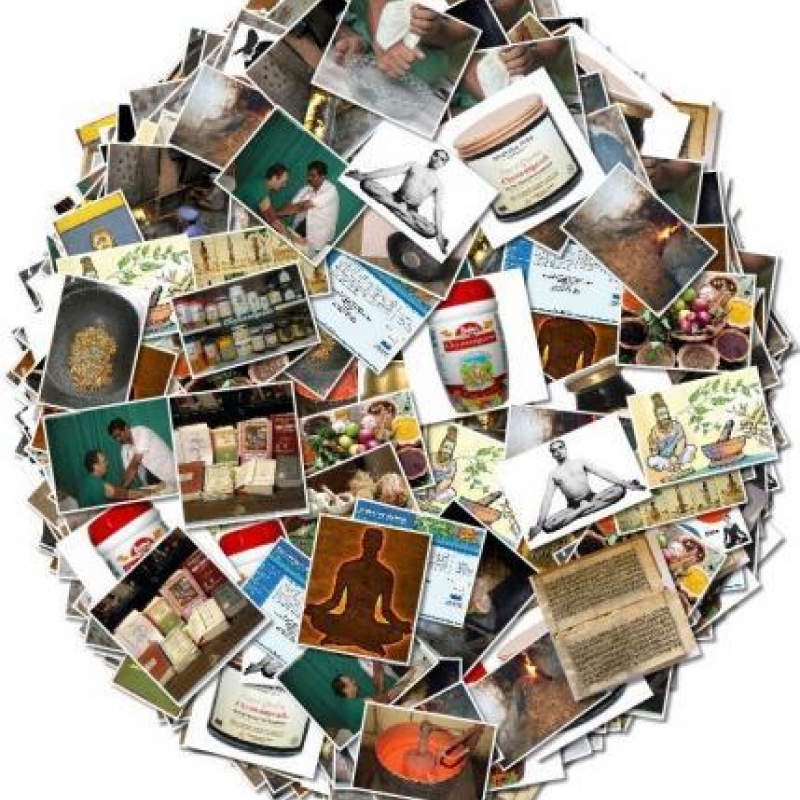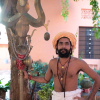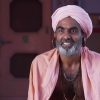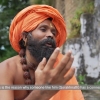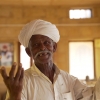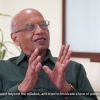Introduction
Traditions promoting physical health and liberation (mokṣa) have often been in dialogue. When seen as a tool for liberation, the human body might need to be maintained at a certain standard of health. Historically, yoga and āyurveda are distinct traditions of knowledge and each have techniques for promoting health. They have become much more closely associated as ‘sister systems’ from the 1970s onwards. This article will specifically outline āyurveda and its relationship to yoga traditions.
Āyurveda was a dominant system of healing in pre-modern India; it continues to be a very popular form of medical treatment in India and the rest of the world. Strictly speaking, the āyurvedic tradition can be understood as a medical tradition referring to a particular canon of Sanskrit texts, some of the most important of which are the Carakasaṃhitā (1st century CE) and the Suśrutasaṃhitā (3rd century CE).[i] Additionally, Vāgbhaṭa’s Aṣṭāṅgahṛdyasaṃhitā (7th century CE) attempts to combine the Suśrutasaṃhitā and the Carakasaṃhitā into a single coherent text. It was widely used between 1400–1850 and continues to be an important resource for contemporary practitioners.[ii]
Āyurveda today can be understood to be the living traditions of medicine which make extensive reference to the above mentioned collections of texts. Āyurveda has both preventative and prescriptive aspects; it addresses general practice, surgery, toxicology, and paediatrics and also provides guidelines for creating life-prolonging elixirs, virility enhancers and treatment for those possessed by supernatural beings. The theoretical understanding of the human body offered by āyurveda is interesting and complex, being substantially different than an understanding based on anatomy. Disease is usually explained as being caused by an imbalance of the constituent elements of the body: doṣa (substances which circulate within the body), dhātu (substances whose quality and relationship to each other shape the physical body) and mala (substances which leave the body). Most popular presentations of āyurveda speak primarily of the three doṣa theory (tridoṣa-upadeśaḥ), namely vāta, pitta and kapha, often glossed into English as air, fire and earth.[iii]
Āyurvedic texts reveal changes in theory and practice over time, such as the adaptation of ingredients to deal with the local availability of plants and other resources; or the addition of new disease categories. Historical reports and contemporary evidence also demonstrate that a variety of ‘āyurvedic’ healing practices incorporate local herbal knowledge, family recipes, cures through rituals, and cures which occur in association with sacred people or places, including with yogis. These healing practices may or may not be closely related to āyurveda as is formally taught and may or may not also present themselves as āyurvedic cures.
Pre-modern connections between yoga and āyurveda
Some of the earliest extant records of medical treatment in the subcontinent were associated with centres of Buddhist and Jain monasticism.[iv] Their techniques of physical and mental discipline are closely associated with practices now identified with yoga and yogis. In this milieu, we probably find some of the roots of what evolved into āyurvedic medicine as well as those of yoga.
Carakasaṃhitā precedes Pātañjalayogaśāstra (4th century CE) and contains a section on yoga in its chapter on the origin and structure of the human being. This chapter describes yoga as both spiritual liberation and the means of attaining it and includes descriptions of supernatural powers which might result from the practice of meditation. In the assessment of Dominik Wujastyk[v], the Carakasaṃhitā’s passage on yoga has closer links to Vaiśeṣika philosophy than to the Sāṅkhya of Patañjali’s system (although it draws from both systems, as well as Buddhism). Additionally, the Pātañjalayogaśāstra contains a brief discussion of disease and the composition of the body using the terms dhātu (bodily constituents), doṣa and vyādhi (disease) which suggests that the author of this text was familiar with an early āyurvedic model of the human body and its understanding of health.[vi]
The Dharmaputrikā (10th to 11th century Nepal), a recently identified text of the Śaiva tradition, presents yoga as a form of therapy. Primarily, this text is a systematic teaching on yoga aiming at liberation (mokṣa), the acquisition of supernatural powers (guṇaiśvarya) and the ability to change the body (parapurañjaya); and it includes descriptions of eight physical postures (āsanas). Significantly, the Dharmaputrikā, which is aimed at householders rather than ascetics, has a chapter named yogacikitsā, that is, ‘therapy in the context of yoga’ which describes ailments caused by the practice of yoga, their significance in progressing towards mokṣa, and how to treat these disorders with further yogic techniques.[vii] This text suggests a greater integration of medicine and yogic practices at an early date than has previously been found.
However, in an extensive review of haṭha yoga and raja yoga works, composed between the 11th and 19th centuries, Jason Birch concludes that:
the evidence suggests that yogins resorted to a more general knowledge of healing disease, which is found in earlier Tantras and Brahmanical texts, without adopting in any significant way teachings from classical Ayurveda. In some cases, it is apparent that yogins developed distinctly Yogic modes of curing diseases.[viii]
Despite this general conclusion, in part because of the very different focuses of yogic texts (on achieving mokṣa and samādhi) and those of the āyurvedic tradition which focus more on physician-client interactions, there are also a few texts which suggest more intriguing overlaps between traditions. For example, the Āyurvedasūtra (16th century) and the Satkarmasaṅgraha (18th century) suggest more extended dialogue between āyurvedic vaidyas (physicians) and yogic sādhakas (practitioners/aspirants).[ix] Additional texts showing explicit dialogue between the traditions are likely to be identified with further research. Our current understanding of the relationship between what is presently seen as two bodies of distinct literature may change.
However, for the individual seeking alleviation from physical pain there is likely to have always been some overlap between yogic and āyurvedic forms of healing.[x] European travelogues suggest that ascetics were sometimes present in the courts of princely states, offering medical advice.[xi] In 19th century Punjab, institutions of learning associated with ascetic orders including those associated with the Dadupanthis, Nath Yogi, Jain as well as Udasi and Nirmala lineages, were known to teach indigenous medical knowledge in their institutions.[xii] Individual sādhus (such as Madhavdasji, guru to both Yogendra and Swami Kuvalyananda) gained reputations as being able to heal both mental and physical problems through yogic techniques and it appears that a kind of ‘sick bay’ evolved at Madhavdasji’s ashram in Malsar in the late 19th century.[xiii] Further research is needed to determine to what extent ascetic institutions served as repositories of medical knowledge in other areas of India throughout the Mughal period and into the colonial one.
The institutionalisation of yoga and āyurveda
In the early 20th century, the use of āsana, prāṇāyāma and kriyā were absent from most descriptions of the theory and techniques of āyurveda, as was any reference to yoga philosophy. Yet by the 21st century, Indian university syllabi for the Bachelors in Ayurvedic Medicine and Surgery (BAMS) require graduates of a five-year programme to have a basic understanding of Pātañjali’s formulation of yoga as well as of therapeutic applications of āsana and prāṇāyāma.[xiv]
The Usman Report, [xv] commissioned in 1923 by the government of Madras, offers an unusual snapshot of āyurvedic, unani and siddha practitioners’ responses to a set of questions about their practices throughout the subcontinent. Yoga as a treatment method does not appear to be a significant element of the practice for those self-identifying as āyurvedic vaidyas at this time.
However, the written testimony in the Usman Report makes it clear that practitioners of South Indian siddha medicine had a closer association to yoga and yogis; there is some evidence of individuals training in both āyurveda and siddha systems. The majority opinion in the Usman Report is that both siddha and āyurvedic systems have common foundations, yet remain distinct in their areas of emphasis and canonical texts.[xvi] Siddha medical literature is primarily written in Tamil while āyurvedic literature was historically written in Sanskrit.[xvii] In 1923, siddha vaidyas did not clearly give evidence of treatment with āsana and prāṇāyāma, but their medical knowledge was explicitly connected to yogis, with one respondent explaining, ‘One can learn this method (Siddha medicine) only from Yogis and not from other people. We also cure diseases using gems (maṇi), mantras and medicine as available in the Tamil system of medicine.’[xviii] One of the central texts of siddha medicine, Tirumantiram (The Sacred Mantra) is also a Śaiva mystico-religious work that combines yoga, medicine and alchemy in an encrypted, poetic language.[xix]
In 1924, Swami Kuvalayananda founded a research centre offering yoga techniques for both general improvement of health and as therapeutic intervention for specific conditions.[xx] Kuvalayananda’s initiatives did much to institutionalise yoga therapeutics as part of the Indian national healthcare system. Also, of significant influence in promoting yogic techniques as health therapy in the early 20th century were the Ghosh College of Yoga and Physical Culture in Calcutta (established in 1923) and Yogendra’s Yoga Institute in Santa Cruz (now a suburb of Mumbai) which offered curative yoga therapy to largely middle-class patrons.[xxi]
Mohandas Karamchand Gandhi (1869–1948), often called Mahatma or ‘great soul’ profoundly influenced understandings about yoga and āyurveda in the 20th century. Gandhi’s anti-colonial conception of swadeshi (Indian-made) encompassed an ideological critique of Western medicine, doctors and hospitals who he saw as agents of colonial oppression. Gandhi was also critical of āyurvedic vaidyas whom he also saw as largely an elite, urban system of medicinal healing.[xxii] In contrast, Gandhi promoted naturopathy (nature cure) as well as yogic forms of cleansing (kriyā) and breathing and strengthening exercises based on āsana and prāṇāyāma, in addition to other forms of Indian physical culture. He saw these as being more accessible to poor and rural populations as well as being uniquely suited to building the physical and moral strength of a self-ruling Indian nation. In early post-independence India, yoga was often paired with naturopathy (and not āyurveda) for promotion by the Ministry of Health.[xxiii] However, in some instances, yoga was more specifically associated with āyurveda, as in the well-publicised rejuvenation treatment of the Indian nationalist Madan Mohan Malaviya at the hands of a yogi.[xxiv]
The state sponsorship of āyurveda, yoga and other forms of indigenous and non-biomedical medicine has been addressed in an uneven way since independence, with many regional variations.
From the late 1960s, the global dominance of biomedicine was slowly challenged by growing counter-cultural and feminist movements which were increasingly identifying limitations and power imbalances.[xxv] The Indian government responded by increasing funding and government regulation and promoting both āyurveda and yoga as therapy.
In 1970, āyurveda was officially recognised as a national system of medicine by the Indian government, which then set up a council for regulating its practice as well as creating and monitoring standards for āyurvedic education.[xxvi] After many years of inconsistent support, yoga was accepted as a component of indigenous systems of medicine on the national level, under the Indian government’s Central Council of Research for Yoga and Naturopathy in 1978. The two departments were united in 2003 under the Ministry of Health as the Department of Ayurveda, Yoga and Naturopathy, Unani, Siddha and Homoeopathy (AYUSH). With the election of the Bharatiya Janata Party to a majority of the Indian parliament in 2014, the department of AYUSH was raised to the level of an independent ministry.[xxvii]
Yoga, āyurveda and popular gurus
In ‘modern yoga’ traditions, which have been enjoying growing global popularity throughout the 20th century, there is often an implicit (and sometimes explicit) assumption that a healthy body (or at least a relatively pain-free body and mind) is a prerequisite for focus on spiritual improvement. In the contemporary world, the goal of mokṣa seems both less clear and less urgent than that of promoting health and well-being.
One of the first Indian yoga teachers to capitalise on a connection between yoga and āyurveda on a global scale was Maharishi Mahesh Yogi (1918–2008). The Maharishi achieved unheard of popularity after attracting the famous band The Beatles who were devotees for a short period in 1967–68. The Maharishi’s teachings in the 1960s were focused on a mantra-based meditation given to initiates in a private ‘vedic’ ceremony. Trademarked as ‘transcendental meditation’, they were presented as scientific in promotional materials. From the late 1970s, the Maharishi began researching āyurveda and āyurvedic pharmaceuticals and established āyur-vedic branded products around 1984. From this period onwards, there has been a ‘mushrooming of ayurvedic luxury resorts, spas and retreats across many of India’s tourist destinations’ which offer ‘expensive “relaxation” and “rejuvenation” therapy, yoga and meditation sessions, lifestyle advice, as well as beauty treatments, to affluent clients, mostly (though not exclusively) from overseas.’ [xxviii]
In the 21st century, a new generation of gurus has united yoga and āyurveda even more closely in popular imagination and in successful commercial businesses. The guru Sri Sri Ravi Shankar (b. 1956), who was previously associated with the Maharishi, opened a Sri Sri branded line of āyurvedic products in 2003. In the same year, Swami Ramdev attracted national attention on India’s Aastha TV station, swiftly becoming one of the most influential promoters of swadeshi Patañjali Yogpeeth-branded yoga and āyurveda throughout India.
Conclusion
To date, scholarly consensus holds that āyurveda and yogic traditions should be understood as historically distinctive traditions that have influenced each other at times over shared areas of interest. However, the two traditions are increasingly closely associated, united primarily under the promotion of health in the physical body. Research on the overlaps between these two traditions is rapidly evolving and ongoing. Further connections may necessitate a revision of this assessment.
Further resources
Interactive Timeline: One of the major aims of the ERC Horizon 2020 funded AYURYOG project is to explore the entanglements of yoga and āyurveda. As a resource to visualise these entanglements in the 20th century, AYURYOG has produced an interactive timeline of key events linked to the entanglement of yoga and āyurveda from the colonial period to the present. It is hoped that a new, updated timeline will expand this to more historical sources.
Acknowledgments
This project has received funding from the European Union’s Horizon 2020 research and innovation program under grant agreement number 639363.
Notes
[i] Wujastyk, ‘The Path to Liberation through Yogic Mindfulness in Early Ayurveda,’ 31–42.
[ii] Wujastyk, The Roots of Ayurveda: selections from Sanskrit medical writings, 193–95. There were also numerous influential texts composed in later periods including those written by Mādhava (700 CE), Śārṅgadhara (1300) and Bhāvamiśra (16th century) as well as more contemporary works.
[iii] Benner, ‘Healing and Medicine in Ayurveda and South Asia,’ 3852–3858.
[iv] Zimmermann, The Jungle and the Aroma of Meats: An Ecological Theme in Hindu Medicine and Zysk, Asceticism and Healing in Ancient India: Medicine in the Buddhist Monastery.
[v] Wujastyk, ‘The Path to Liberation through Yogic Mindfulness in Early Ayurveda,’ 4.
[vi] Maas, ‘The Concepts of the Human Body and Disease in Classical Yoga and Āyurveda,’ 125–162.
[vii] Barois, ‘Eight Yoga Postures in the Dharmaputrikā,’ 2017; ‘Medical Practices of Yogins in Medieval India: The testimony of the Dharmaputrikā.’
[viii] Birch, ‘Premodern Yoga Traditions and Ayurveda: Preliminary Remarks on Shared Terminology, Theory and Praxis,’ 5.
[ix] Slatoff, ‘Seeds of Modern Yoga: The Confluence of Yoga and Ayurveda in the Āyurvedasūtra’; Meulenbeld, A History of Indian Medical Literature, 499–501.
[x] Kakar, Shamans Mystics and Doctors.
[xi] For example, Honigberger Thirty-five Years in the East: Adventures, Discoveries, Experiments and Historical Sketches relating to the Punjab and Cashmere in connection with Medicine, Botany, Pharmacy and together with an original Materia Medica and a Medical Vocabulary in Four European and Five Eastern Languages, 92–95 and 116, records a “faqueer’s” acting as one of several medical advisors to those in power in Lahore during the early 1800s.
[xii] Sivaramakrishnan, Old Potions, New Bottles: Recasting Indigenous Medicine in Colonial Punjab (1850-1945).
[xiii] Rodrigues, Life of Shri Yogendra: The Householder Yogi, 43–44 and 47.
[xiv] Central Council of Indian Medicine, ‘Ayurveda Syllabus—Curriculum.’ However, there are interesting suggestions that some early āyurvedic institutions might have included Patañjali in their syllabi for vaidyas much earlier, for example, the Mumbai-based Prabhuram Ayurvedic College (established in 1896 as the Aryan Medical College), claims to have been teaching this from the late 19th century (Ayurved Sadhana, About Us).
[xv] Usman, Muhammad et al., 'The Report of the Committee on the Indigenous Systems of Medicine, Madras [1921–1923].'
[xvi] Usman, Muhammad et al., 'The Report of the Committee on the Indigenous Systems of Medicine, Madras [1921–1923],' 3 and 82.
[xvii] Barois, Newcombe and Wujastyk (forthcoming).
[xviii] Usman, Muhammad, et al., 'The Report of the Committee on the Indigenous Systems of Medicine, Madras [1921–1923],' 340.
[xix] Kędzia, ‘Mastering Deathlessness’; Weiss, Recipes for Immortality: Medicine, Religion and Community in South India.
[xx] Newcombe, ‘The Revival of Yoga in Contemporary India;’ Alter, Yoga in Modern India: The Body between Science and Philosophy.
[xxi] Alter, ‘Shri Yogendra: Magic, Modernity, and the Burden of the Middle-Class Yogi’; Elliott Goldberg, The Path of Modern Yoga: The History of an Embodied Spiritual Practice; Mark Singleton, Yoga Body: The Origins of Modern Posture Practice, 116-122.
[xxii] Newcombe, ‘The Revival of Yoga in Contemporary India;’ Alter, Gandhi’s Body: Sex, Diet, and the Politics of Nationalism; Yoga in Modern India: The Body between Science and Philosophy; and Tidrick, Gandhi: A Political and Spiritual Life, 213.
[xxiii] Alter, ‘Yoga, Nature Cure and “Perfect” Health: The Purity of the Fluid Body in an Impure World;’ Brass, ‘The Politics of Ayurvedic Education: A Case Study of Revivalism and Modernization in India,’ 342–71.
[xxiv] Newcombe 'Yogis, Ayurveda, and Kayakalpa: The Rejuvenation of Pandit Malaviya'.
[xxv] Newcombe, 'Global Hybrids? ‘Eastern Traditions’ of Health and Wellness in the West.'
[xxvi] Leslie, Asian Medical Systems: A Comparative Study.
[xxvii] Ministry of AYUSH, ‘About the Ministry.’
[xxviii] Warrier, ‘Modern Ayurveda in Transnational Context,’ 86; a shift previously observed by Zimmerman, ‘Gentle Purge: The Flower Power of Ayurveda;’ Zysk, ‘New Age Āyurveda or What Happens to Indian Medicine When It Comes to America.’.
Bibliography
Alter, Joseph S. ‘Yoga, Nature Cure and “Perfect” Health: The Purity of the Fluid Body in an Impure World.’ In Yoga in Transformation: Historical and Contemporary Perspectives, edited by Karl Baier, Philipp A. Maas and Karin Preisendanz, 439–462. Göttingen: V&R unipress, 2018. https://www.vandenhoeck-ruprecht-verlage.com/themen-entdecken/theologie/religionswissenschaft/16133/yoga-in-transformation
———. ‘Shri Yogendra: Magic, Modernity and the Burden of the Middle-Class Yogi.’ In Gurus of Modern Yoga, edited by Mark Singleton and Ellen Goldberg, 60-82. New York: Oxford University Press, 2014.
———. Gandhi’s Body: Sex, Diet, and the Politics of Nationalism. Philadelphia: University of Pennsylvania Press, 2000.
———. Yoga in Modern India: The Body between Science and Philosophy. Princeton, NJ and Oxford: Princeton University Press, 2004.
Armstrong, Jerome. Calcutta Yoga: Buddha Bose and the Yoga Family of Bishnu Ghosh and Yogananda. Webstrong, 2018.
Ayurved Sadhana. ‘About Us.’ 2018. https://www.ayurvedsadhana.com/about-us/.
Barois, Christèle. ‘Eight Yoga Postures in the Dharmaputrikā.’ 2017. http://ayuryog.org/blog/eight-yoga-postures-dharmaputrik%C4%81
———. ‘Medical Practices of Yogins in Medieval India: The testimony of the Dharmaputrikā.’ In History of Science in South Asia (forthcoming).
Barois, Christèle, Suzanne Newcombe and Dagmar Wujastyk. ‘Introduction to new translations of the Usman Report (1923).’ eJournal of Indian medicine (forthcoming).
Benner, Dagmar. ‘Healing and Medicine in Ayurveda and South Asia.’ In Encyclopedia of Religion, edited by Lindsay Jones, 3852–3858. New York: MacMillan, 2005.
Birch, Jason Eric. ‘Premodern Yoga Traditions and Ayurveda: Preliminary Remarks on Shared Terminology, Theory and Praxis.’ History of Science in South Asia 6 (2018): 1–83. https://doi.org/10.18732/hssa.v6i0.25
Brass, Paul. ‘The Politics of Ayurvedic Education: A Case Study of Revivalism and Modernization in India.’ In Education and Politics in India, edited by Susanne H. and Lloyd I. Rudolph. Cambridge, MA: Harvard University Press, 1992.
Central Council of Indian Medicine. ‘Ayurveda Syllabus—Curriculum.’ 2017. https://www.ccimindia.org/ayurveda-syllabus.php
Goldberg, Elliott. The Path of Modern Yoga: The History of an Embodied Spiritual Practice. Rochester, Vermont: Inner Traditions, 2016.
Honigberger, John Martin. Thirty-five Years in the East: Adventures, Discoveries, Experiments and Historical Sketches relating to the Punjab and Cashmere in connection with Medicine, Botany, Pharmacy and together with an original Materia Medica and a Medical Vocabulary in Four European and Five Eastern Languages. London: H. Bailliere, 1852.
Kakar, Sudhir. Shamans Mystics and Doctors. Chicago: Chicago University Press, 1982.
Kędzia, Ilona Barbara. ‘Mastering Deathlessness.’ History of Science in South Asia 5, no. 2 (2017): 121–142. https://doi.org/10.18732/hssa.v5i2.16
Leslie, Charles. Asian Medical Systems: A Comparative Study. Berkeley: University of California Press, 1998.
Langford, Jean M. (2002). Fluent Bodies: Ayurvedic Remedies for Postcolonial Imbalance. London: Duke University Press.
Maas, Philipp A. ‘The Concepts of the Human Body and Disease in Classical Yoga and Āyurveda.’ Wiener Zeitschrift für die Kunde Südasiens / Vienna Journal of South Asian Studies 51 (2007–08): 125–162.
Meulenbeld, Gerrit Jan. A History of Indian Medical Literature. Groningen: E. Forsten, 1999–2002.
Ministry of AYUSH. ‘About the Ministry.’ Ministry of AYUSH. http://ayush.gov.in/about-us/about-the-ministry
Newcombe, Suzanne. 'Global Hybrids? ‘Eastern Traditions’ of Health and Wellness in the West.' In The Gaze of the West and Framings of the East, edited by Shanta Nair-Venugopal, 202–17. New York: Palgrave Macmillan, 2012.
———. ‘The Revival of Yoga in Contemporary India.’ In Oxford Research Encyclopaedia of Religion, 2017.
———. 'Yogis, Ayurveda, and Kayakalpa: The Rejuvenation of Pandit Malaviya' History of Science in South Asia 5, no. 2 (2017): 85-120. https://doi.org/10.18732/hssa.
Rodrigues, Santan. Life of Shri Yogendra: The Householder Yogi. Mumbai: The Yoga Institute, 2008.
Slatoff, Zoë. ‘Seeds of Modern Yoga: the Confluence of Yoga and Ayurveda in the Āyurvedasūtra.’ 2017. http://ayuryog.org/blog/seeds-modern-yoga-confluence-yoga-and-ayurveda-%C4%81yurvedas%C5%ABtra.
Singleton, Mark. Yoga Body: The Origins of Modern Posture Practice. New York: Oxford University Press.
Sivaramakrishnan, Kavita. Old Potions, New Bottles: Recasting Indigenous Medicine in Colonial Punjab (1850-1945). Hyderabad: Orient Longman, 2006.
Tidrick, Kathryn. Gandhi: A Political and Spiritual Life. London: I. B. Tauris, 2006.
Usman, Muhammad, et al. 'The Report of the Committee on the Indigenous Systems of Medicine, Madras [1921–1923].' Madras: Government of Madras, Ministry of Local Self-Government, Committee on the Indigenous Systems of Medicine, 1923.
Warrier, Maya. ‘Modern Ayurveda in Transnational Context.’ Religion Compass 5, no. 3 (2011): 80–93.
Weiss, Richard S. Recipes for Immortality: Medicine, Religion and Community in South India. New York: Oxford University Press, 2009.
Wujastyk, Dagmar. ‘On Perfecting the Body. Rasāyana in Sanskrit Medical Literature.’ Aion xxxvi (2015): 55–77.
Wujastyk, Dagmar and Fredrick M. Smith. Modern and Global Ayurveda: Pluralism and Paradigms. Albany: SUNY Press, 2008.
Wujastyk, Dominik. The Roots of Ayurveda: selections from Sanskrit medical writings. London: Penguin, 2003.
———. ‘The Evolution of Indian Government Policy on Ayur-veda in the Twentieth Century.’ In Modern and Global Ayurveda: Pluralism and Paradigms, edited by Dagmar Wujastyk and Fredrick M. Smith, 43–76. New York: SUNNY University Press, 2008.
———. ‘The Path to Liberation through Yogic Mindfulness in Early Ayurveda.’ In Yoga in Practice, edited by David G. White, 31–42. Princeton: Princeton University Press, 2011.
Zimmermann, Francis. The Jungle and the Aroma of Meats: An Ecological Theme in Hindu Medicine. New Delhi: Motilal Banarsidass, 1999.
———. ‘Gentle Purge: The Flower Power of Ayurveda.’ In Paths to Asian Medical Knowledge: A Comparative Study, edited by Charles Leslie and Allen Young, 209–23. Delhi: Munshiram Manoharlal, 1992.
Zysk, Kenneth Asceticism and Healing in Ancient India: Medicine in the Buddhist Monastery. Delhi: Motilal Banarsidass Publishers. 2000 [1991].
———. ‘New Age Āyurveda or What Happens to Indian Medicine When It Comes to America.’ Traditional South Asian Medicine 6 (2001): 10–26.
